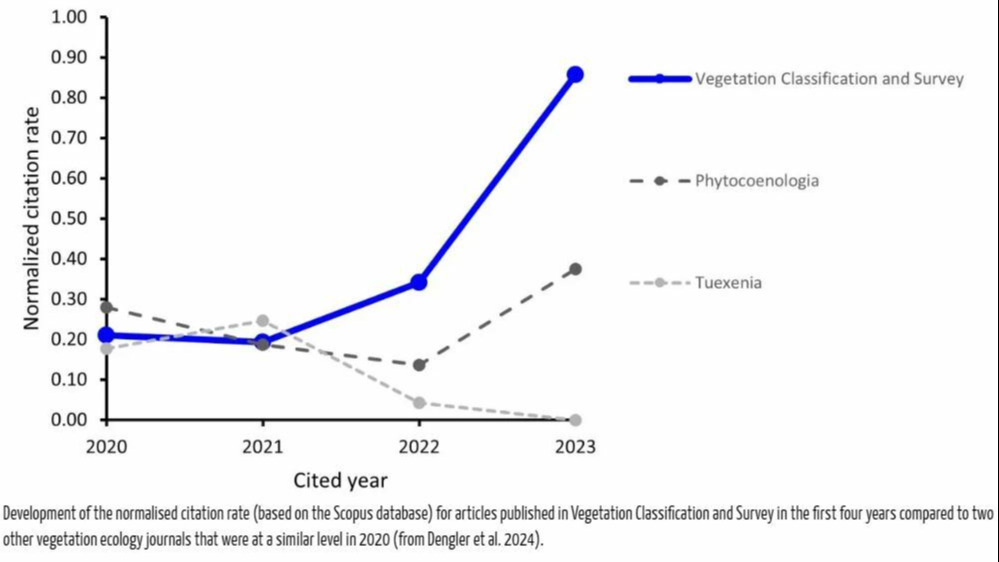Editorial looks back & forward after the completion of the 4th volume of Vegetation Classification and Survey

The post is provided by Editor-in-Chief Jürgen Dengler (on behalf of all Vegetation Classification and Survey Chief Editors), originally published on the IAVS blog, and refers to the recently published Editorial paper, titled "Vegetation Classification and Survey is performing well".
Vegetation Classification and Survey (VCS) has just completed its fourth issue. Nearly 100 papers have now been published. The fourth volume was the largest to date with 25 papers and a total of 360 pages.
The journal’s development is also reflected in its bibliometric data. In 2022, it was included in the Scopus database, and in the summer of 2023, VCS received its first CiteScore of 2.0. The CiteScoreTracker has since risen to 2.4. The application for inclusion in the Web of Science Core Edition is currently under review, and we hope for a positive decision during 2024. While both CiteScore and Journal Impact Factors are mainly based on the citation performance of papers published in the third year prior to the release of the respective metric (and to some extent in the second year prior), in this year’s editorial (Dengler et al. 2024) the Chief Editors tried to get a more up-to-date picture by using normalized citation rates for the publication output of VCS in single years (see the figure above). Among a selection of 30 ecological journals at all levels, from Tuexenia to Global Change Biology, VCS improved its average normalized citation rate from 0.21 for articles published in 2020 to 0.86 for articles published last year. The latter was in the range of journals such as Biodiversity and Conservation or Basic and Applied Ecology, both of which reached 0.75. Accordingly, the ranking of VCS improved from 28th to 14th among these 30 journals (for details, see Dengler et al. 2024).
VCS is global in scope, focusing on those biodiverse regions of the world that are underrepresented in most ecological journals. From the outset, we have had a regionally diverse editorial board. The addition of Alireza Naqinezhad (Iran) and Gaolathe Tsheboeng (Botswana) as Associate Editors from 2024 will further broaden our expertise. VCS is also dedicated to serving the regional sections and working groups of IAVS. To this end, we have a Permanent Collection on Phytosociological Nomenclature (published in collaboration with the GPN Working Group) and one on Ecoinformatics (associated with the EcoInformatics Working Group). There are currently four ongoing Special Collections in collaboration with five Regional Sections and Working Groups. Two are in their final stages (“Neotropical vegetation” together with the Regional Section Latin America and the Caribbean, “African vegetation studies” together with the Regional Section Africa), one is ongoing (“Grasslands of Asia” together with the Regional Section Asia and the Working Group EDGG), and one has just started (“Classification and diversity of European forests and forest edges” together with the Working Group EVS).
VCS is a gold open-access journal, which means that production costs must be covered either by the authors through article processing charges (APCs) or by the owner (IAVS) through subsidies. Charging APCs in the early years of a new journal while it is still awaiting inclusion in the Scopus and Web of Science databases would be challenging. Moreover, APCs could prevent good articles from being submitted simply because their authors do not have access to APC funding sources, which is often the case in the field of vegetation classification, where many authors come from low-income countries or from outside large research institutions in wealthier countries. We are therefore very grateful to the IAVS Council for having fully covered the APCs for articles submitted by IAVS members during the first four years.
However, these subsidies were always intended for the initial phase only, while later VCS is expected to cover its costs through APCs and even to generate some profit for IAVS, as the other two journals (JVS, AVS) do. As a first step in this direction, since 2022, IAVS members who have access to their own APC funding have been encouraged to use that money rather than rely on IAVS grants. This approach has worked increasingly well, so that the IAVS subsidy per year has stagnated or fallen, despite the increasing number of pages. To this end, we have increased the basic APCs to 2000 EUR in autumn 2023. Any author who chooses to pay this from their institutional or project funds is doing a real service to the community, as this will essentially enable about two articles by authors without such funding to be published. So, a big thank you to all authors who have paid their APCs instead of having them paid by IAVS! Now that VCS is included in the Scopus database and has a CiteScore, IAVS members will have to pay partial APCs from 2024 onwards. Specifically, articles submitted in 2024 by authors from rich countries are subject to an 85% price reduction, i.e. the APCs for a standard article of 8–20 pages is 300 EUR, while authors from middle and low-income countries are still completely exempt from APCs.
We, the Chief Editors, believe that the scope of the journal, the performance of the journal, and the close cooperation with the IAVS Working Groups and Regional Sections, combined with the low APCs, make VCS an attractive publication venue for vegetation ecologists. We therefore look forward to receiving many exciting manuscripts from IAVS members in 2024!
Reference:
Dengler, J., Biurrun, I., Jansen, F. & Willner, W. 2024. Vegetation Classification and Survey is performing well. Vegetation Classification and Survey 5: 1–10. https://doi.org/10.3897/VCS.118454
***
Keep yourself updated with news from Vegetation Classification and Survey on Twitter and Facebook. You can also follow IAVS on Twitter and join the Association's public group on Facebook.